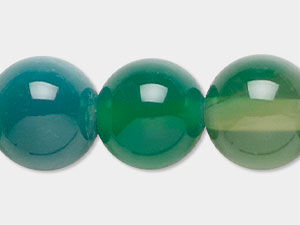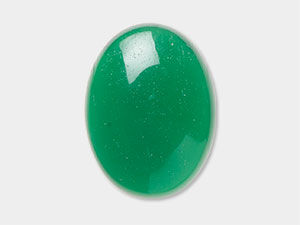Agate, Green Meaning and Properties
Green Agate History
This beautiful, translucent deep green stone goes back to the Egyptians. At least 3,000 years ago, they were using agate for seals, rings and decorating vessels. Agate is named after the Achates River (now called the Dirillo) on the island of Sicily in the Mediterranean, an ancient source of this gemstone. The art of dyeing it into vibrant colors began with the Romans.
Today, not only does it continue to be popular for art objects and jewelry, industry also "loves" agate because of its hardness and resistance to chemicals.
What are the Metaphysical Properties of Green Agate?
Even before we knew about Feng Shui, the ancient Chinese art of placement and color, most of us knew we felt better when we had green plants and trees around us. According to Feng Shui, that's because green is a benevolent, humanistic color—and green agate meaning is right in line with that. Like all color, it affects us even when we don't know it.
In this stone, the spiritual power of green is said to be combined with that of agate. According to modern healers who use stones in healing, green agate increases compassion, generosity and a keen sense of justice, along with enhancing mental and emotional flexibility, improving decision-making and resolving disputes. It also encourages these traits in others.
What Chakra is Green Agate?
Since ancient times, gemstones have been seen as more than adornments—they were vessels of energy, symbols of healing and quiet companions on the journey of the soul. Green agate, with its gentle, grounding energy, is traditionally linked to the heart chakra, the center of compassion, balance and emotional truth. Green agate meaning is believed to steady the heartbeat of both body and spirit, and this stone is said to encourage calm resilience, deepen self-acceptance and open the heart to quiet strength and enduring love. In wearing or working with green agate, one is said to tap into an old, earth-born wisdom that still speaks in the language of the heart.
Heart Chakra (Anahata) - Green
- Location: chest (breastbone)
- Represents: the union of male and female principles; ability to love
- Emotional issues: compassion; trust; forgiveness; compassion; complex emotions; tenderness; equilibrium; love
- Spiritual issues: devotion
- Physical issues: immune system; cardio-vascular system; lungs
- Gemstones: amazonite, aventurine, green agate, jade, malachite, moss agate, peridot, rhodonite, rhodochrosite, rose quartz, tree agate
What is Green Agate Made From?
Formed from microscopic crystals of quartz, agate is usually a banded stone with a blend of opaque and translucent layers. The banding is what often separates agate from other forms of chalcedony. Deposits containing agate are commercially mined on almost every continent (including Oregon in the United States), making this a highly affordable and beautiful gemstone.
Agate is formed by layers of silica filling voids in other minerals. The layers form in stages, often with high contrast as riverbeds, ashfalls or other environmental elements change over time. Since they are filling in openings in (primarily) volcanic rock, agates are usually formed in rounded nodules or knobs. Each agate is unique, as it is created by filling a different shaped void. When the void fills entirely, a full agate is formed. When it is only partially filled by silica, the hollow center often becomes filled with crystalline quartz (called "druzy") lining the inside—a common component of geodes or "thundereggs."
When found, most agates are visually dull and require cutting or polishing to reveal their inner color banding. Commercial values on natural stones (stones without any enhancements) are frequently determined by the fineness, sharpness and bold color contrasts within the bands.
Agate has historically been carved into cameos , using the natural differences in band colors to create profiles and scenes. Other uses beyond jewelry include handles, boxes and other items for personal care and home décor.
- Mineral Information: Microcrystalline quartz, banded chalcedony—often infused with iron and aluminum
- Chemical Composition: SiO2
- Color: Deep green
- Hardness: 6-1/2 to 7 (Mohs)
- Specific Gravity: 2.60 – 2.65
- Refractive Index: 1.544 – 1.553
How Do You Clean Green Agate?
Clean agate using warm soapy water and a soft brush. Although it has a high hardness, agate can still be scratched or damaged by gemstones with a higher hardness, as well as other materials. Avoid using household chemicals when cleaning agate beads, components or jewelry. Agates can be sensitive to heat, especially dyed stones, and prolonged exposure to sunlight can fade color-enhanced types. Store agate inside a fabric-lined box or wrapped in a soft cloth.
Green Agate FAQ
Q: Is green agate dyed?
A: While some subtle shades of green agate occur naturally, the vivid, jewel-toned greens commonly seen in the gemstone market are typically the result of dyeing—a practice that dates back to ancient times and continues today to enhance the stone’s striking color.
Q: Why are some green agate beads a light green and not dark green?
A: Because much of the green agate on the jewelry market is dyed, its color can be tailored to suit different tastes and styles. However, softer, more muted shades of green may indicate naturally occurring green agate.
Q: How is green agate used in home décor?
A: The uses for green agate in home décor are only limited by your imagination! Whether displayed as a striking tabletop stone, carved into a sculpture, or incorporated into a multi-gemstone wall hanging or wind chime, it adds organic charm and color. For more functional style, green agate also shines in bookends, coasters, drawer pulls and other everyday accents.
Designing with Green Agate
Combine these delicate-looking opulently green beads with small copper beads and brass or silver-plated heishi beads for jewelry people will want to pass on for generations. Another alternative is to use beads of complimentary colors for a striking, high contrast design.
Shop for Green Agate
**Please note that all metaphysical or healing properties listed are collected from various sources. This information is offered as a service and not meant to treat medical conditions. Fire Mountain Gems and Beads® does not guarantee the validity of any of these statements.
How did you like this resource? Your feedback helps us provide resources that matter to you most.
Copyright Permissions
All works of authorship (articles, videos, tutorials and other creative works) are from the Fire Mountain Gems and Beads® Collection, and permission to copy is granted for non-commercial educational purposes only. All other reproduction requires written permission. For more information, please email copyrightpermission@firemtn.com.


